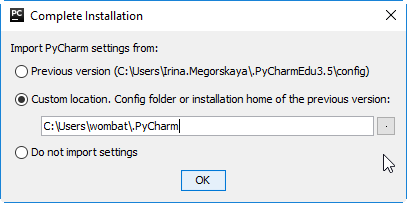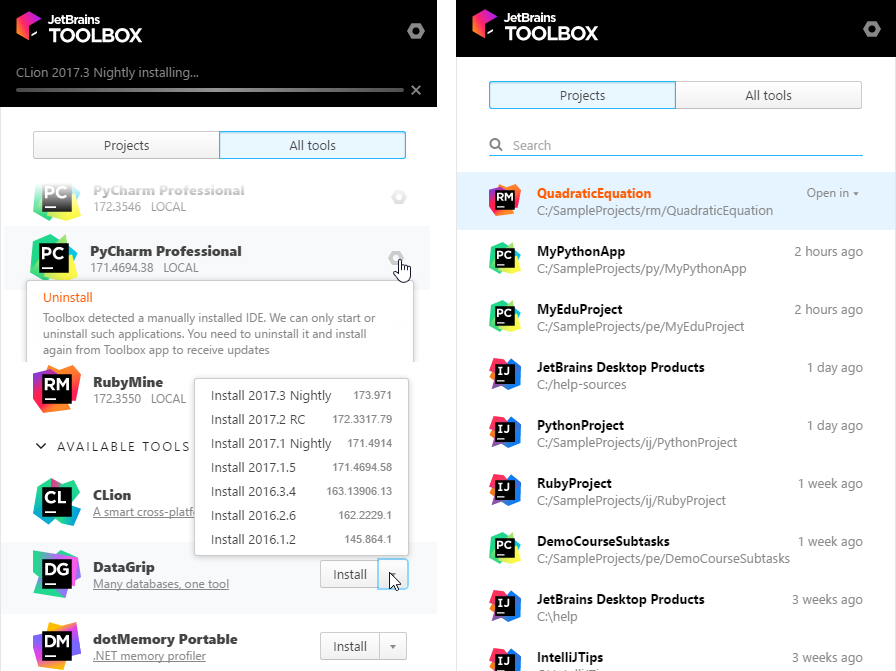Requirements, Installation and Launching
PyCharm editions
There are two PyCharm editions: Community and Professional.
The Community Edition is free and open source but has less features. The Professional Edition is commercial but provides an outstanding set of tools and features. (You can evaluate PyCharm Professional for free for 30 days.)
For more information, see feature-by-feature Editions comparison matrix.
Downloading PyCharm
You can download the latest version of PyCharm from the JetBrains website. (There are the versions for Windows, macOS and Linux.)
Earlier versions are available on the Previous PyCharm Releases page.
Requirements
The requirements for PyCharm are as follows:
Hardware requirements
System requirements
JRE 1.8 is bundled with distributions for all platforms. You don't need any Java to be installed on your machine in order to run PyCharm.
Windows
- Microsoft Windows 10/8/7/Vista/2003/XP (incl.64-bit)
- Python 2.4 or higher, Jython, PyPy or IronPython.
macOS
- macOS 10.5 or higher.
- Only 64-bit macOS is supported.
- Python 2.4 or higher, Jython, PyPy or IronPython
Linux
Installing PyCharm
The installation process depends on your operating system:
Installing PyCharm on Windows
Run the .exe file that you've downloaded, and follow the instructions of PyCharm Setup wizard.
Installing PyCharm on macOS
Open the .dmg package that you've downloaded, and drag PyCharm to the Applications folder.
Installing PyCharm on Linux
Unpack the .tar.gz archive that you've downloaded, into any desired installation location. The whole process is described below:
- Unpack the
<pycharm-professional or pycharm-community>-*.tar.gzfile to a different folder, if your current "Download" folder doesn't support file execution:tar xfz <pycharm-professional or pycharm-community>-*.tar.gz -C <new_archive_folder>The recommended install location according to the filesystem hierarchy standard (FHS) is
/opt. For example, it's possible to enter the following command:sudo tar xf <pycharm-professional or pycharm-community>-*.tar.gz -C /opt/ - Switch to the
bindirectory:For example,cd <new archive folder>/<pycharm-professional or pycharm-community>-*/bincd opt/<pycharm-professional or pycharm-community>-*/bin
Launching PyCharm
Since 2016.1 PyCharm uses Java 1.8. If you wish to change JDK PyCharm is running on, use the action Switch boot JDK. To invoke this action, use Searching Everywhere or Find Action.
Starting PyCharm on Windows
If during the installation you selected to create a shortcut on your desktop, double-click that shortcut.
Otherwise, go to the <PyCharm>\bin folder (e.g. C:\Program Files (x86)\JetBrains\PyCharm 2017.1\bin) and run pycharm.exe, pycharm64.exe, or pycharm.bat.
Starting PyCharm on macOS
In the Application folder, double-click the PyCharm icon.
Starting PyCharm on Linux
Run pycharm.sh from the bin subdirectory.
Importing preferences from a previous version
When you start PyCharm for the first time, the Complete Installation dialog opens, and you have an option of importing PyCharm usage preferences and license information from a previous version.

Select one of the following options and click OK.
- I want to import my settings from a previous version (<path>). If this option is present in the dialog, the directory that contains the PyCharm settings and license information is found at its default location. (The corresponding path is shown within the option name in parentheses.) Most likely, this is the option that you want.
- I want to import my settings from a custom location. You may have the directory with the settings and license information available but not at its default location. If the option discussed above is missing, PyCharm doesn't know where this directory is; the path initially shown in the field is just a guess, and there's no guarantee that the necessary folder is really there. To import the settings in this case, you can specify the folder with the settings (if you know where it is), or an installation folder of the previous PyCharm version. To do that, click
 and select the folder in the dialog that opens .
and select the folder in the dialog that opens . - I do not have a previous version of PyCharm or I do not want to import my settings. If this is your case, select this option.
Coming from another IDEs
Your transition to PyCharm may be easier, if you look at these pages:
Managing PyCharm through Toolbox App
Toolbox App is an control panel that allows you to manage all JetBrains developer tools, as well as your projects, from a single point of access. It lets you maintain different versions of the same tool, install updates and roll them back if needed. It also remembers your JetBrains Account and uses it to automatically log you in when you install and register new tools.
To install Toolbox App, follow these steps:
- Download Toolbox App.
- Launch the file you've downloaded.
- When the installation is complete, accept the JetBrains privacy policy and sign in to your JetBrains Account.
